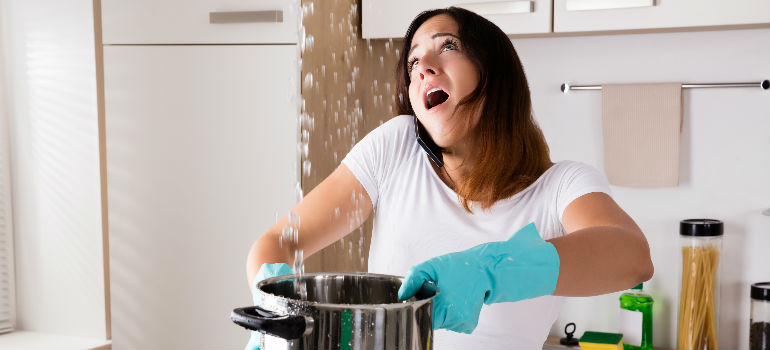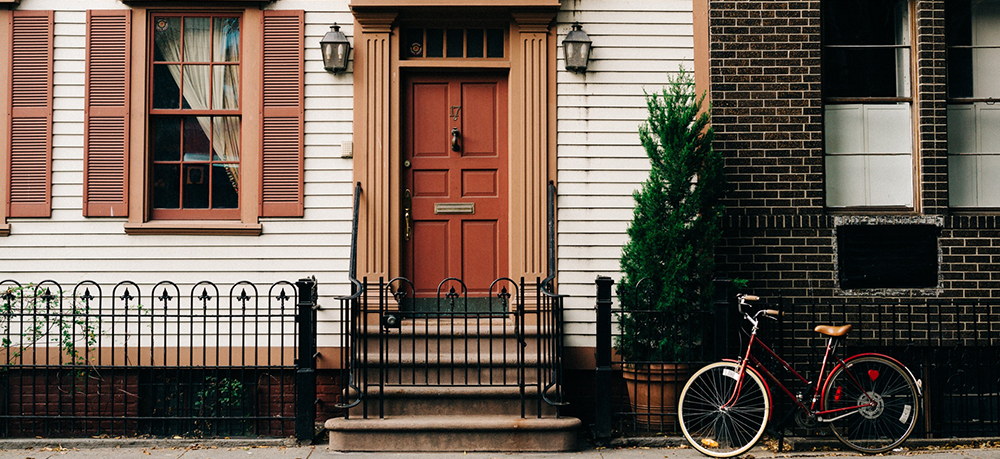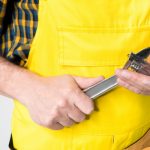
Two of the most hated words for homeowners are “leaky roof”. Upon hearing them, most homeowners will shudder and a panicked expression will take over their face. It is understandable why replacing a roof or having it professionally repaired can be an extremely expensive nightmare.
However, all is not lost as you still might be able to repair that leak until you can afford a new roof. With this guide and a little bit of common sense, you will be able to find and repair that small soul-destroying leak in a jiffy.
Table of Contents
What causes roof leaks?
There are many reasons as to why your roof is leaking. We will go through the seven most common reasons below.
- Age. Roofing materials, just like everything else in life, are not immune to the effects of the passage of time. Throughout the years, your roof is also subjected to the full force of nature. These two undeniable forces act together to eat away at the durability of your roof, which will lead to a greater chance of leaks forming.
- Damaged chimney. Although chimney stacks are often among the strongest parts of a house, they too are subjected to the effects of weather and time. Leaks can form in chimneys when the bricks and mortar develop cracks or when the chimney crown becomes damaged.
- Flashing. Flashing is the metal sheeting that is installed in areas that are vulnerable to leaks, such as around the base of a chimney or where the roof meets a wall. If the flashing was installed incorrectly or is damaged, it can create a gap large enough for water to get through.
- Missing shingles/tiles. From time to time, you may find a roof tile or shingle in your garden or on your driveway. This is usually caused by a powerful storm, but other factors can loosen tiles and shingles as well. A roof that is constructed of tiles or shingles relies on each individual piece to keep the whole roof watertight. If one or more of these pieces are missing, this creates a hole or a gap that allows water to seep through.
- Holes. If there is a hole, or multiple holes, in your roof, it should come as no surprise that there are leaks. Holes in a roof are about as beneficial as holes in the bottom of a bucket.
- Clogged gutters. Clogged gutters are a common and often overlooked leak-causing problem. The guttering of your house is there to ensure that rainwater or that of melting snow is safely diverted away from your home. Clogs in your gutters form small dams, which allow water to build up and extend its presence on your rooftop.
- Skylights. Skylights can have a transformative effect on rooms in your home. They allow for better ventilation and for more natural light to enter your home. However, if a skylight is installed incorrectly or substandard materials are used, they can become a dripping, leaky nightmare. Most skylight leaks are caused by poor workmanship when either the skylight or the protective flashing is not installed correctly.
How to find roof leaks
Finding the source of a leak can be quite troublesome since the water will often travel from the original entry point. This means that the signs of a leak and the actual leak are often separated by quite a large distance.
To find the source of a leak, grab a flashlight and head into your attic during the day. Remember, only step on the large support beams and avoid the insulation or the top side of the ceiling, unless you also enjoy repairing ceilings. — the insulation and the ceiling cannot support your weight.
- Start your search from the place where the leak came through the ceiling;
- Think about the way water behaves on sloped surfaces;
- Look for signs of water damage, discolouration, mould, and dampness on the support beams above;
- Switch off the flashlight to look for daylight shining through holes or large cracks;
- Once you have found the source of the leak, check the rest of the roof for any other signs of damage.
Need a Handyman?
Enter your postcode to view our rates and availability in your area.
For questions about the services we offer visit our main site or you can always call us at 020 3404 4045
How to fix a leaky roof
Now that you have found the source of the leak, it is time to repair the cause. It is recommended that you have at least one other person helping you out to make the task easier, as well as to quickly react in case of an emergency. Since the three most common roofing materials in the UK are tile, shingle, and asphalt flat roof, we will only focus on how to repair these three types.
Shingle
What you will need:
- Replacement shingles;
- A pry bar or crowbar;
- Hammer;
- Roofing nails;
- Roofing adhesive.
What to do:
- Lift the damaged shingle up by hand.
- Remove the old nails with the hammer.
- Use your pry bar or crowbar to gently lift the shingle above the damaged area.
- If your replacement shingle is pre-cut to the correct length and shape, slide it into position. If not, cut the shingle down to the correct length and then slide it into place.
- Fasten the new shingle to the roof with the roofing nails and a hammer.
- Apply roofing adhesive to the heads of every used nail and firmly press the shingle down.
Check also:
How to Keep House Safe from Floods
Asphalt flat roof
What you will need:
- A patching kit and primer;
- A paint brush;
- Scissors;
- A flat roof roller.
What to do:
- Clean the area around the damage to remove any debris.
- Liberally apply a coat of primer to the damaged area, as well as the surrounding material. Apply the primer approximately 5cm in every direction from the centre of the damaged area.
- Allow the primer to dry if instructed to do so by the packaging.
- Cut the self-adhesive patching material to the desired shape.
- Apply the patching material to the damaged area and firmly press it down.
- Smooth the material out with the flat roof roller to make sure that it is properly applied and that the damaged area is sealed.
Check also:
How to Keep Your House Safe from Electrocution
Tile
What you will need:
- A replacement tile or a clear roofing sealant;
- Hammer;
- Pry bar or crowbar;
- Tile clip or roofing nails.
What to do:
- Locate the damaged tile and assess whether it is damaged beyond repair or not.
- If the tile is only cracked, carefully lift the tile and apply the roofing sealant to the area beneath the tile.
- Place the cracked tile back into position and firmly press it down.
- Apply more sealant to the top of the tile to seal up the crack.
- If the tile is damaged beyond repair, lift the tile above the damage using the pry bar or a crowbar.
- Remove the damaged tile, if possible. If not, carefully smash it with the hammer and remove the pieces.
- Replace the damaged tile with the new one and secure it using a tile clip or a roofing nail, if needed.
- Slowly remove the pry bar or crowbar to lower the tile above onto the new replacement.
Check also:
How to Fix a Broken Pipe inside a Wall
How to prevent leaks in the roof
Repairing or replacing a roof can be time-consuming and expensive, but there are some things you can do to extend the lifespan of your roof.
- Hire a professional, and reputable roofing company for any repairs that you are not confident you can carry out yourself.
- Keep your gutters clean and clear of debris so that water can easily drain away.
- Perform an annual inspection of your roof to check for signs of damage, especially after large storms.
- Make sure your attic is well insulated and ventilated.
So there we have it, your guide on how to fix a leaky roof. It may seem complicated at first glance, but it is simpler than it may appear. Simply locate the source of the leak and take the appropriate action to repair it.
But, if you are not confident in your ability to safely complete the repairs, do not forcefully put yourself in a dangerous situation. Paying for a professional is much better than paying with your own health.
Image Source: Andrey_Popov/shutterstock.com




I would never try to fix a roof myself. But that may be because I do not like ladders or heights. I think a professional maintenance team is the best bet when a roof starts leaking. But if you are confident with DIY your tips are great
Roof leak is the nightmare of home owners. Can be very expensive to fix and some times will have to replace whole roof. So this article is valuable for all who wants to fix their roof leaks by your self or want to contact a expert. Thank you for the post cheers.
Awesome post. Although it is feasible to fix a leak on your roof by yourself, it is advisable to hire experts to ensure your own safety and to prevent the leak from worsening.
Finding the source of a leak can be quite troublesome since the water will often travel from the original entry point. Treat it for Epdm roof coating and get relaxation.
Damaged chimney, flashing, missing shingles, holes, clogged gutters are some of the common problems for roof leaks. Also, other reasons for the same can be tree damage, pooled water, poor ventilation, membrane shrinkage, which needs to prevent in order to keep the roof safe.
If it s necessary to replace an entire row of shingles, or if you find that shingles lift off from the roof too easily, it may be time to call in a professional roofer to inspect the situation. Spot repairs will not extend the life of a roof in need of replacement .
This post is worth everyone’s attention. Good work.
I found your article really useful, thanks for writing it! You have a way with words that just keeps me reading. Please keep posting more posts like this one. I’m sure others will find them helpful too 🙂
Thanks, Fantastic Team For sharing the fantastic article. I tried it once but I did not repair it. So I called a professional roofer and he repaired. So my suggestion is that If you know the process then you apply otherwise not.
Thank you for mentioning clogged gutters! We speak to a lot of clients that don’t realise a clogged gutter can end up damaging their roof, especially if left for a long time. Many also don’t realise that any damage caused by clogged gutters might not be covered in their home insurance as the damage was avoidable if they kept up home maintenance.